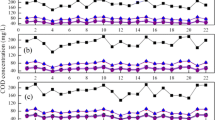Abstract
The experimental results and material balance analysis in this paper revealed the regularity of poly-hydroxy alkanoates (PHA) and total phosphorus (TP) metabolism in a continuous-flow single-sludge wastewater treatment system under different main anoxic section oxidation-reduction potential (ORPan) conditions. We also evaluated the effectiveness of the operation control parameters of ORPan as the continuous-flow single-sludge sewage treatment system from the aspect of the reaction mechanism. Using a programmable logic controller (PLC) automatic control system to take the circulating flow in nitrification as the controlled variable based on the feedback control structure, an experimental study was carried out under the condition of ORPan setting value of −143mV, −123mV, −105mV, −95mV, −72 mV and −57mV, respectively, with other operational design parameters remaining unchanged. Influent water quality of chemical oxygen demand/total nitrogen (COD/TN) was 5.0±0.6. The results showed that when ORPan was set at −95mV, the maximum values of PHA synthesis and storage rate, PHA degradation rate, phosphorus release rate and phosphorus absorption rate in anaerobic and pre-anoxic segments were 82.34, 7.90, 47.31, 14.27, 1.50 and 8.52mg/ (L·h), respectively. According to the metabolic mechanism of PHA and TP, ORPan was further proved to be the operation control parameter of the continuous-flow single-sludge sewage treatment system, and when the COD/TN value was 5.0±0.6, the optimal setting value was −95mV.
Similar content being viewed by others
References
Y. Sun, Z. Chen, G. X. Wu, Q. Y. Wu, F. Zhang, Z. B. Niu and H. Y. Hu, J. Cleaner Production, 131, 1 (2016).
Y. Yang, Y. S. Ok, K. H. Kim, E. E. Kwon and Y. F. Tsang, Sci. Total Environ., 596-597, 303 (2017).
J. Guerrero, A. Guisasola and J. A. Baeza, Water Res., 45, 4793 (2011).
Y. X. Zhu, X. J. Tu, X. S. Chai, Q. Wei and L. N. Guo, Bioresour. Technol., 251, 7 (2018).
W. Zeng, L. Li, Y. Y. Yang, X. D. Wang and Y. Z. Peng, Enzyme Microb. Technol., 48, 134 (2011).
Q. Y. Yuan and J. Oieszkiewicz, Desalination and Water Treatment, 22, 72 (2010).
A. G. Kapagiannidis, I. Zafiriadis and A. Aivasidis, New Biotechnol., 30, 227 (2013).
H. M. Zou and Y. Wang, Bioresour. Technol., 221, 87 (2016).
S. M. Souza, O. Q. F. Araújo and M. A. Z. Coelho, Bioresour. Technol., 99, 3213 (2008).
E. Vaiopoulou and A. Aivasidis, Chemosphere, 72, 1062 (2008).
J. M. Duan, W. Li, K. Zhao and J. Krampe, Desalination and Water Treatment, 40, 24 (2012).
L. Peng, X. H. Dai, Y. W. Liu, J. Sun, S. X. Song and B. J. Ni, Chemosphere, 197, 430 (2018).
G. Bortone, S. Marsili Libelli, A. Tilche and J. Wanner, Water Sci. Technol., 40, 177 (1999).
J. H. Wang, L. Wang, E. Y. Cui and H. Lu, Korean J. Chem. Eng., 35, 1274 (2018).
Y. V. Nancharaiah, S. Venkata Mohan and P. N. L. Lens, Bioresour. Technol., 215, 173 (2016).
M. A. Cardete, J. Mata-Álvarez, J. Dosta and R. Nieto-Sánchez, J. Environ. Chem. Eng., 5, 3472 (2017).
X. L. Wang, J. Yin and S. Gao, Environ. Sci., 33, 175 (2012).
G. B. Zhu, Y. Z. Peng, S. Y. Wang, S. Y. Wu and B. Ma, Chem. Eng. J., 131, 319 (2007).
A. Soares, P. Kampas, S. Maillard, E. Wood, J. Brigg, M. Tillotson, S. A. Parsons and E. Cartmell, J. Hazard. Mater., 175, 733 (2010).
J. Bergendahl and L. Stevens, Environ. Progress, 24, 214 (2005).
P. Pagacova, A. Blstakova and M. Drtil, Continually Measured ORP and pH Signal for Control of Nitrogen Removal, Springer Netherlands (2002).
M. V. Ruano, J. Ribes, A. Seco and J. Ferrer, Chem. Eng. J., 183, 212 (2012).
Y. Ma, Y. Z. Peng and S. Y. Wang, China Environ. Sci., 25, 252 (2005).
H. T. Kim, G. S. Kim, S. W. Shin, S. H. Oh and K. H. Kim, KSCE J. Civil Eng., 9, 73 (2005).
X. Liu, Q. W. Chen and L. Zhu, J. Environ. Sci., 47, 174 (2016).
S. H. Chuang and C. F. Ouyang, Water Res., 34, 2283 (2000).
I. G. München and I. K. Braunschweig, Design of Single Stage Activated Sludge Wastewater Treatment Plant, GFA Publishing Company, Hennef (2000).
Water Environment Federation, Design of Municipal Wastewater Treatment Plants, Volume 2: Liquid Treatment Processes, McGraw-Hill, Inc., New York (2010).
Shanghai Municipal Engineering Design Institute (Group) Co., LTD, Code for design of outdoor wastewater engineering, China Planning Press, Beijing (2016).
X. F. Wang, Method for Monitoring and Analyzing Water and Waste Water, China Environmental Science Press Pub, Beijing (2002).
A. C. Maizel and C. K. Remucal, Water Res., 122, 42 (2017).
X. L. Wang, T. H. Song and X. D. Yu, Desalination and Water Treatment, 56, 1877 (2015).
X. L. Wang, T. H. Song and Y. Yin, Environ. Sci., 36, 2617 (2015).
P. Caulet, B. Bujon, J. P. Philippe, F. Lefevre and J. M. Audic, Water Sci. Technol., 37, 41 (1998).
T. Kuba and M. C. M. van Loosdrechtt, Water Sci. Technol., 27, 241 (1993).
M. Henze, M. C. M. van Loosdrecht, G. A. Ekama and D. Brdjanovic, Biological Wastewater Treatment: Principles, Modelling and Design, IWA Publishing, London (2010).
N. Boontian, Eng. Technol., 64, 984 (2012).
D. S. Bi, X. P. Guo and D. H. Chen, Water Sci. Technol., 67, 1953 (2013).
M. G. Kim and G. Nakhla, Water Environ. Res., 82, 69 (2010).
R. Qi, T. Yu, Z. L. Li and D. Li, J. Environ. Sci., 24, 571 (2012).
Author information
Authors and Affiliations
Corresponding author
Rights and permissions
About this article
Cite this article
Wang, X., Lu, H., Song, T. et al. The effects of main anoxic section oxidation-reduction potential on the metabolism of PHA and TP in continuous-flow single-sludge treatment system. Korean J. Chem. Eng. 36, 411–422 (2019). https://doi.org/10.1007/s11814-018-0213-7
Received:
Accepted:
Published:
Issue Date:
DOI: https://doi.org/10.1007/s11814-018-0213-7




